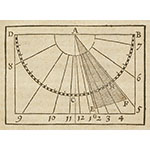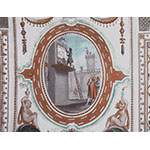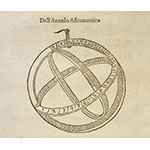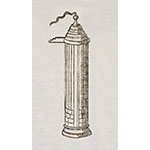The sundial operates on the basis of the apparent motion of the Sun. It consists of a gnomon or style that projects the solar shadow on a surface engraved with a set of hour lines. The lines vary according to the type of dial (declining, vertical, horizontal, etc.) and the latitude for which the dial is calibrated. Dials were designed in several shapes: column, cylinder, polyhedron, book, scaphe, equinoctial (when the gnomon is parallel to the terrestrial axis and the dial is parallel to the plane of the equator), etc. They could also be calibrated for different latitudes (universal dials). To display the correct hour, the clock had to be oriented north, an operation performed with a compass.
Sundial built by plotting the meridian line generated by the intersection of the vertical plane of the meridian circle with the horizon plane (horizontal dial) or with the quadrant plane (vertical dial). The meridian line indicates the north-south direction. From remote antiquity, the meridian line was plotted by following the direction of the shortest shadow projected by a vertical gnomon in the course of a day.
Sundial with armillae (rings). The Sun's ray shows the time when it passes through a hole bored in one of the rings and hits the opposite inner face of that ring, which carries the set of hour lines. The armillae indicate the main circles of the celestial sphere: meridian, equator, and solstitial colure. If it carries the shadow scale, the ring dial can also be used to measure distances. The variety of its functions is illustrated in the collection of writings by several authors (including Regiomontanus, Reiner Gemma Frisius, and Oronce Finé) printed in Paris by Gulielmum Cavellat in 1557 under the title Annuli astronomici... usus.
One of the oldest sundial models, also called "cup dial." Its invention is attributed to the Babylonians. It carries a gnomonic projection of the hour divisions of the equatorial circle on a concave hemispheric surface. This represents the back of the celestial sphere, whose center is symbolized by the tip of the horizontal gnomon.
In use in the Christian West as early as the tenth century, this model features hour lines engraved on the surface of a vertical cylinder. The horizontal gnomon is attached to the revolving head of the cylinder so that it can be positioned on the date of the time-reading.
The most widely used model of sundial, thanks to its ability to give the time all day long. It carries a gnomonic projection of the hour divisions of the equatorial circle on a horizontal plane. The gnomon is inserted in the dial plane in alignment with the celestial axis, and its tip indicates the center of the celestial sphere. The hour lines are marked on the quadrant as straight lines converging toward a point that represents the projection of the celestial poles. The hour lines are intersected by the equinoctial line (projection of the equinoctial circle) and by the declination curves (projections of the parallel circles lying between the Tropic of Cancer and the Tropic of Capricorn). The meridian line divides the hour lines symmetrically, intersecting the equinoctial at a right angle.
Also called "polar" sundial, as its plane is oriented toward the celestial poles. Carries a gnomonic projection of the hour divisions of the equatorial circle on a plane parallel to the celestial axis. The gnomon consists of a vertical plate, set on the meridian line, whose summit represents the celestial axis. Unlike in other sundials, the hour lines in this model are all parallel. Called universal because it can be used at any latitude.
Typically installed on building facades, this type of dial bears a gnomonic projection of the hour divisions of the equatorial circle on a vertical plane. The gnomon is set on the dial plane in the direction of the celestial axis, and its tip denotes the center of the celestial sphere. The dial is called "direct," if the vertical plane directly faces one of the cardinal points, or "declining," if the plane is oriented in any other direction.
Dial consisting of a disk parallel to the celestial equator engraved with the hour lines based on the divisions of the equatorial circle. The center of the disk holds an orthogonal gnomon pointing in the direction of the celestial axis.
Sundial based on the laws of light-ray refraction. Generally consists of a hemispheric bowl or cup filled with water. The hour lines are traced on the bottom of the vessel, obviously allowing for the refraction angle of the sunbeam that projects the shadow of the gnomon. A variant of this model replaces the water with a crystal globe whose center coincides with the tip of the gnomon; the hour is shown by the point of light formed by the concentration of sunbeams. This type of dial, including many other variants, is described by Athanasius Kircher (1602-1680) in the Ars magna lucis et umbrae (Rome, 1646), in the context of what he calls "anaclastic gnomonics."
Dial based on the laws of light-ray reflection. Can be horizontal, vertical, polar, equinoctial or hemispheric. The layout of the hour lines is reversed with respect to that of the most common sundials, as it allows for the angles of reflection of the sunbeams deviated from the surface of a small mirror that replaces the gnomon. A variant of this instrument is the reflecting-refraction (anacamptic-anaclastic) dial, which also uses the laws of refraction; it consists of a concave hemisphere filled with water and bearing two facing sets of hour lines that receive either the shadow from the small mirror or the reflected ray. The reflecting dial, with its many variants, is described by Athanasius Kircher in the Ars magna lucis et umbrae (Rome, 1646), in the context of what he calls "anacamptic gnomonics."











